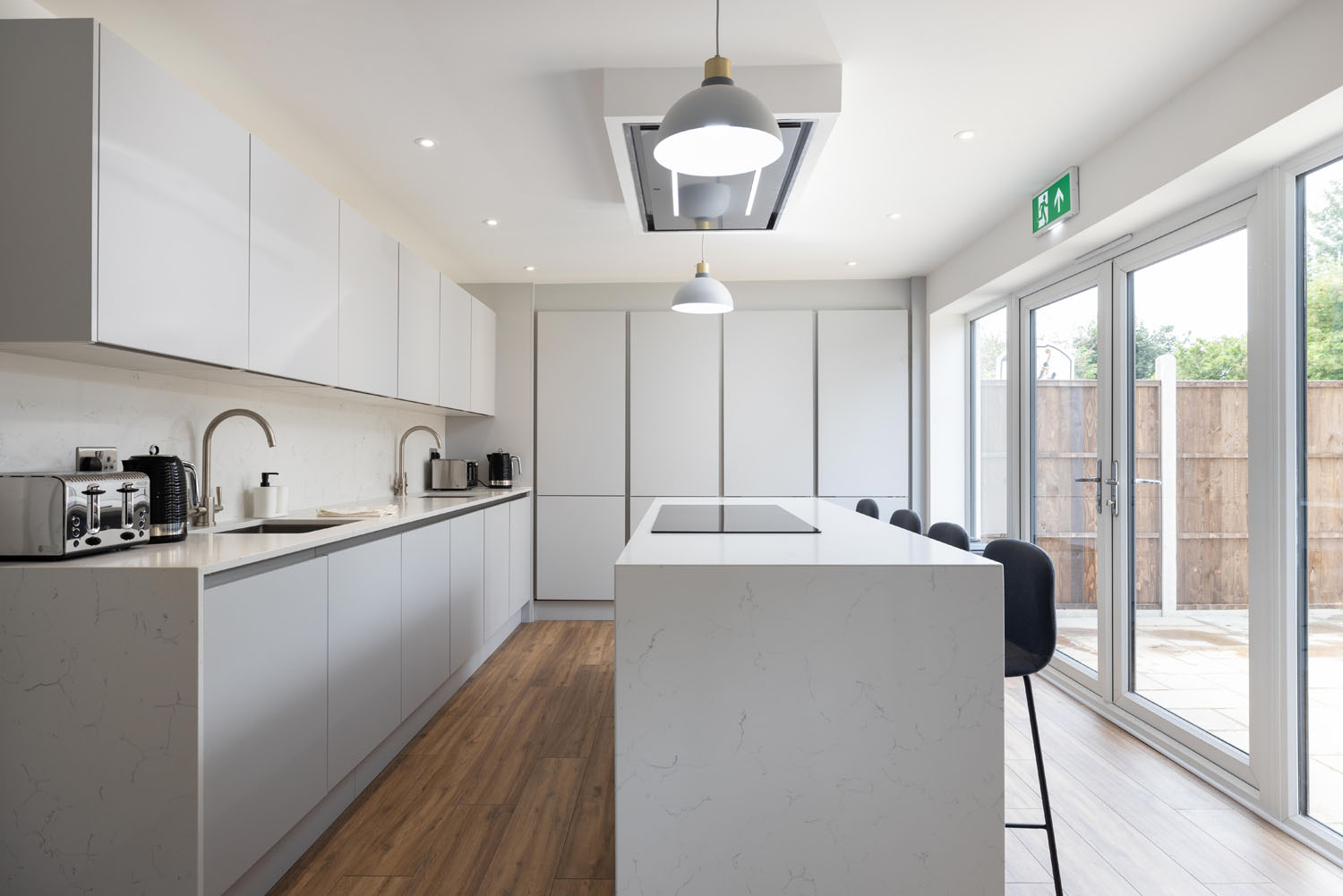
What Is a Joint Borrower Sole Proprietor Mortgage?
A Joint Borrower Sole Proprietor (JBSP) mortgage allows you to increase your borrowing potential by adding a family member or friend to the mortgage without giving them legal ownership of the property. It’s a smart solution for buyers whose income alone doesn’t meet lender affordability checks — particularly first-time buyers and young professionals receiving support from parents.
With a JBSP mortgage, two or more people are responsible for the mortgage repayments, but only one person (the proprietor) is named on the property deeds. This means that your helper (for example, a parent) won’t own part of your home, avoiding potential Stamp Duty complications on second homes.
How Does a JBSP Mortgage Work?
Here’s a simple breakdown:
- Both borrowers are assessed for affordability and creditworthiness.
- The main buyer is listed as the sole proprietor on the title deeds.
- The supporting borrower(s) – often parents or close relatives – are listed as joint borrowers on the mortgage only.
- All borrowers are equally responsible for ensuring monthly repayments are made.
- When the main buyer’s income increases, the supporting borrower can usually be removed from the mortgage via a remortgage or product transfer.
Example:
Emily wants to buy her first home for £350,000. Her income alone isn’t enough to borrow the full amount. Her father, Paul, agrees to be a joint borrower on a JBSP mortgage. His income helps boost the overall affordability, allowing Emily to buy the property in her name alone — while Paul isn’t added to the title deeds.
Trinity Finance Kent Office
Opening Hours
Monday: 9 am–5 pm
Tuesday: 9 am–5 pm
Wednesday: 9 am–5 pm
Thursday: 9 am–5 pm
Friday: 9 am–5 pm
Saturday/Sunday: Closed
Latest Testimonials

Who Can a JBSP Mortgage Help?
A Joint Borrower Sole Proprietor mortgage is ideal for:
- First-time buyers struggling to meet affordability on their own
- Parents who want to help their children buy a home without becoming co-owners
- Couples where one partner has a strong income but limited credit history
- Siblings buying together but wishing to keep ownership simple
It’s particularly useful for those who want family support without triggering Stamp Duty Land Tax (SDLT) charges or complicating ownership rights.

Risks and Considerations
Before applying, it’s important to understand the potential risks:
- Shared liability: All borrowers are equally responsible for missed payments.
- No ownership rights for the helper: The supporting borrower can’t claim equity in the property.
- Age limits: Some lenders impose maximum age limits for the supporting borrower.
- Exit strategy: Plan ahead for when and how the helper will be removed from the mortgage.
- Affordability checks: All incomes and debts are considered during application.
Speak to an expert JBSP Mortgage adviser
Our specialist mortgage brokers are here to guide you through the entire mortgage and finance process, helping you secure the best mortgage deal tailored to your needs.

Louis Chalk
Associate Director

Emma Taylor
Mortgage Consultant

Omer Mehmet
Managing Director

Contact Form
Our JBSP Mortgages
Book an appointment with our JBSP mortgage specialist 01322 907 000
Stamp Duty Calculator
Use our stamp duty calculator to instantly calculate the stamp duty (SDLT) payable in England and Northern Ireland. This stamp duty calculator provides you with an insight into your stamp duty liability when purchasing a freehold residential property.
Get your credit reports for free
Your mortgage adviser may request copies of your credit reports during your consultation – you can download them for free by accessing a *free trial from our affiliate partners here:
Credit Reports*The link above is our referral link—we may receive a small commission if you use it. The trial is free for 30 days and £14.99/month after, cancel anytime.
FAQs
What is payable for the joint borrower sole proprietor mortgage first-time buyer stamp duty?
As a first-time buyer, you benefit from a stamp duty exemption up to a certain threshold. That means if the property you’re buying is valued within that threshold, you don’t have to pay any stamp duty. If your property is valued higher than that amount, you only pay the stamp duty rate that’s applicable for the remaining portion.
For example, until 31st March 2025, no stamp duty is payable as a first-time buyer for a property with a value of up to £425,000. A rate of 5% becomes payable for the portion between £425,001 and £625,000. No stamp duty relief can be claimed for a property worth over £625,000.
The first-time buyer stamp duty relief rates will change from 1st April 2025. No stamp duty will be payable up to a value of £300,000. For the portion between £300,001 and £500,000, 5% will be payable. If buying a property valued over £500,000 as a first-time buyer, you won’t be able to claim any stamp duty relief.
Can you get a joint borrower sole proprietor buy-to-let mortgage?
Yes, some joint borrower sole proprietor mortgage providers offer buy-to-let mortgages. Generally, they stipulate that a higher deposit has to be paid for this type of JBSP mortgage. As an example, a lender may be willing to offer up to a 95% loan-to-value (LTV) ratio for a standard residential JBSP mortgage but will offer a lower LTV of 75% for a buy-to-let JBSP mortgage.
Is there a joint borrower sole proprietor mortgage age limit?
Lenders differ in their criteria when it comes to the age limit for a JBSP mortgage. Some, for example, may stipulate that borrowers mustn’t be over 70 years old when the mortgage term ends. Others may set 80 as the age limit at the end of the mortgage term. Some lenders may accept a non-owner borrower who will be 80 if the sole proprietor accepts responsibility for a larger share of the mortgage loan, such as 70%.
The mortgage term for your JBSP mortgage will be determined by the age of the oldest borrower. Bear in mind that the shorter the term, the higher your monthly payments will be.
What happens if the sole proprietor stops paying the mortgage?
With this type of mortgage, each borrower is jointly and severally liable for making the mortgage payments. This means that if the sole proprietor defaults on the payments, the non-owner borrower is liable to pay them.
Can you apply for a joint borrower sole proprietor mortgage as a married couple?
Yes, some lenders allow married couples to take out JBSP mortgages. In this case, you are both named on the deeds so you both have ownership of the property. The borrower who has applied for the mortgage with you both to help you out financially isn’t named on the deeds. This means that they are liable for the mortgage payments but have no legal claim over the property.
How does a joint mortgage differ from a JBSP mortgage?
A joint mortgage allows two to four people to buy a property together. Each person is named on the property deeds and the mortgage. This means that each person is a co-owner of the property and is jointly liable for the mortgage payments.
With a joint borrower sole proprietor mortgage, each person is jointly responsible for the mortgage payments but only one person is named on the property deeds. The non-owner borrower is, therefore, financially helping the other borrower to become a homeowner. The non-owner borrower has no financial claim over the property. They also cannot usually live in the property, depending on the lender’s stipulations.
What happens if the sole proprietor dies?
If you, as the legal property owner, should pass away before the end of the mortgage term, the executors of your will would need to put the property up for sale. The proceeds of the sale would then be used to repay the outstanding mortgage debt. The non-owner borrower would have to keep making the full mortgage payments until the property is sold.
What happens if the non-owner borrower dies?
Should the non-owner borrower pass away, you need to get in touch with the lender to make them aware. As with any mortgage, the payments still have to be made but they may be able to offer support while you try to make other arrangements. If you’re unable to make arrangements and cannot afford the mortgage payments on your own at that point, you may have to sell the property.
It’s best to get in touch with our mortgage brokers if the joint borrower has passed away. We know this is a difficult situation to deal with and can liaise with the lender on your behalf and offer support when you need it the most.
Can you get a joint borrower sole proprietor mortgage with bad credit?
It can be more challenging to get a JBSP mortgage with bad credit but it’s not impossible. Lenders vary in how they look at bad credit issues but, generally, they take into account the severity of the issue, how long ago it occurred and the amount involved. Our mortgage brokers will approach the most appropriate lender on your behalf to meet the needs of your situation.
How many people can apply for a joint borrower sole proprietor mortgage?
Up to four people can usually apply for a JBSP mortgage together. Some lenders, however, stipulate a lower number of applicants, such as two.
Can any family member help with a joint borrower sole proprietor mortgage?
Lenders differ in their flexibility on who can assist you as the non-owner borrower. Some don’t have any restrictions on the relationship between you, even allowing friends to apply, not just family members. Others insist on a familial connection, with some accepting immediate family members only.
How does a guarantor mortgage differ from a JBSP mortgage?
With a JBSP mortgage, each borrower’s income is taken into account for the affordability criteria, increasing your borrowing potential. As each borrower is named on the mortgage, you are jointly liable for the mortgage payments from the start of the mortgage term.
For a guarantor mortgage, the person acting as your guarantor needs to provide the lender with some form of security. This is in case you default on the mortgage and the security can be their own property or their savings. Your guarantor will only become liable for the mortgage payments if you’re unable to make them.
Can you have a sole mortgage for a joint property?
This type of arrangement is hard to find but there are some lenders who will agree to it. Usually, though, there have to be exceptional circumstances. Having a property with joint owners when one is not liable for the mortgage payments considerably increases a lender’s risk.
How can a joint borrower leave the mortgage?
A JBSP mortgage is designed to enable someone to buy a property with financial help from a joint borrower. The aim is for the sole proprietor to take over the mortgage payments on their own at a later date when they’re in a position to do so. At that point, as long as the lender agrees, the sole proprietor can remortgage, allowing the non-owner borrower to be released from the JBSP mortgage arrangement.
Aside from this, circumstances change and the non-owner borrower may wish to be released from the mortgage arrangement. For example, they may want to buy a property of their own. In this instance, you need to contact the mortgage lender. The lender will then decide whether or not this is possible based on your ability to repay the mortgage loan on your own. If so, they will issue a deed of release.
Alternatively, you and the non-owner borrower can agree to sell the property and repay the mortgage loan from the proceeds.
Can the joint borrower get a mortgage on another property?
As the non-owner borrower has a financial obligation with a JBSP mortgage, it may affect their affordability when it comes to being approved for another mortgage. They must declare their JBSP mortgage commitment to a mortgage broker or lender when applying for one. As long as they meet the new lender’s affordability criteria despite also being legally liable for the JBSP mortgage payments, they can get another mortgage for another property.
Joint Borrower Sole Proprietor Topics
Which Lenders Offer JBSP Mortgages?
As an experienced mortgage broker, Trinity Finance has access to a wide panel of lenders currently offering JBSP mortgage products, including:








